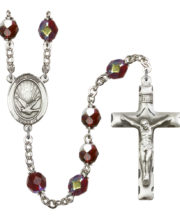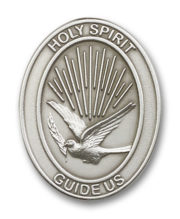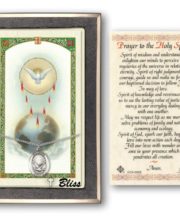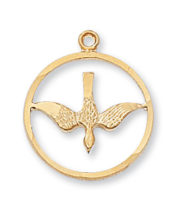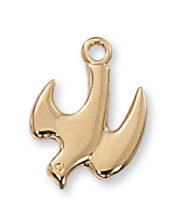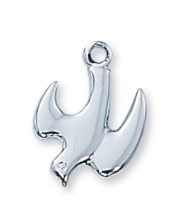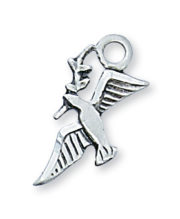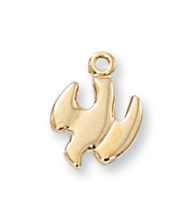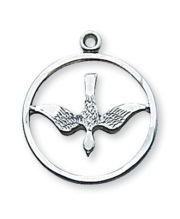Religious Education
What is the Holy Spirit?
“But when he comes, the Spirit of truth, he will guide you to all truth. He will not speak on his own, but he will speak what he hears, and will declare to you the things that are coming.” John 16:13
The Holy Spirit, also known as the Holy Ghost, is the third person of the Holy Trinity in the Christian faith. The Holy Trinity consists of the Father (God), the Son (Jesus Christ), and the Holy Spirit, and it is a central doctrine of the Catholic Church and many other Christian denominations.
The Holy Spirit is often described as the presence of God in the world, and as the source of divine grace and inspiration. In the New Testament, the Holy Spirit is depicted as descending upon Jesus at his baptism and as inspiring the apostles and other followers of Jesus to proclaim the Gospel and to perform miracles.
The Holy Spirit is also seen as the source of the gifts and fruits of the spirit, which are described in the New Testament as love, joy, peace, patience, kindness, goodness, faithfulness, gentleness, and self-control. Catholics believe that the Holy Spirit helps them to grow in holiness and to live out the teachings of Jesus.
Overall, the Holy Spirit is an important and central figure in the Christian faith, and Catholics and other Christians look to the Holy Spirit for guidance, inspiration, and strength in their spiritual lives.
What are the fruits of the Holy Spirit?
The fruit of the Holy Spirit is a biblical term that refers to the nine character traits that the Holy Spirit produces in the life of a believer. These traits are love, joy, peace, patience, kindness, goodness, faithfulness, gentleness, and self-control.
The fruit of the Holy Spirit is described in the Bible in the book of Galatians, where it says: “But the fruit of the Spirit is love, joy, peace, patience, kindness, goodness, faithfulness, gentleness, self-control; against such things there is no law” (Galatians 5:22-23).
These traits are not qualities that we can produce on our own, but are the result of the Holy Spirit working in our lives. When we allow the Holy Spirit to control our thoughts and actions, we will naturally exhibit these qualities as we grow in our relationship with God.
The fruit of the Holy Spirit is a powerful witness to the transformative power of God’s love, and it is an essential part of the Christian life. As believers, we are called to bear fruit for the glory of God and to be a positive influence in the world.
What does the Catechism of the Catholic Church teach about the Holy Spirit?
“To believe in the Holy Spirit is to profess that the Holy Spirit is one of the persons of the Holy Trinity, consubstantial with the Father and the Son” CCC685
According to the Catechism, the Holy Spirit is one of the three persons of the Holy Trinity, together with the Father and the Son. He is the “Lord and Giver of Life,” who proceeds from the Father and the Son and is equal to them in all things.
The Holy Spirit is active in the creation and sustenance of the universe, and he is present in the lives of all people, offering them gifts and helping them to grow in holiness. He is especially active in the life of believers, dwelling within them and transforming them through his presence and power.
The Holy Spirit is also the source of the Church’s life and mission. He leads the Church and inspires its members to share the Good News of Jesus Christ with the world. He gives the Church the gifts of prophecy, wisdom, and discernment, and he guides the Church in its understanding and interpretation of the Bible.
“The Holy Spirit is at work with the Father and the Son from the beginning to the completion of the plan for our salvation.” CCC 686
What has the Pope said about the Holy Spirit?
Pope Francis has had much to say about the Holy Spirit in his papacy. Here are a few examples of his teachings on the Holy Spirit:
-
In his apostolic exhortation “Evangelii Gaudium” (“The Joy of the Gospel”), Pope Francis wrote about the importance of being open to the promptings of the Holy Spirit and of allowing the Holy Spirit to guide and transform our lives. He said: “The Holy Spirit gives life and this gift is always new. He is the living water that flows from the side of Christ, the living water that quenches our thirst for God and enables us to bear fruit” (Evangelii Gaudium, no. 39).
-
In his encyclical “Laudato Si'” (“On Care for Our Common Home”), Pope Francis wrote about the need to listen to the voice of the Holy Spirit, which helps us to discern God’s will and to act in accordance with it. He said: “The Holy Spirit can awaken new prophetic voices who can warn of the danger of compromising the integrity of creation, and can also inspire others to devise innovative solutions to these problems” (Laudato Si’, no. 66).
-
In a homily given on the feast of Pentecost in 2015, Pope Francis spoke about the importance of the Holy Spirit in the life of the Church and in the life of individual believers. He said: “The Holy Spirit is not simply a ‘force’ or an ‘influence’; he is not a ‘power’ or a ‘principle’. No, he is a person, the third Person of the Blessed Trinity, the personal love that God has for us. And this is the mystery of the Holy Spirit: he is the love between the Father and the Son, he is the love that unites them and makes them one” (Homily, Pentecost Sunday, 2015).
These are just a few examples of Pope Francis’ teachings on the Holy Spirit. As the leader of the worldwide Catholic Church, the Pope has a great deal of influence and his teachings on the Holy Spirit and other matters are an important source of guidance and inspiration for Catholics and for others interested in the teachings of the Church.
How is the Holy Spirit depicted?
The Holy Spirit is depicted in various ways in different artistic traditions and in different contexts. In general, the Holy Spirit is often depicted as a dove, which is a symbol of the Holy Spirit that is rooted in the Bible. In the New Testament, the Holy Spirit is described as descending upon Jesus in the form of a dove at his baptism (Matthew 3:16 and Mark 1:10). The dove is also a symbol of peace and purity, which are qualities that are associated with the Holy Spirit.
In addition to being depicted as a dove, the Holy Spirit is also sometimes depicted as a flame or as a circle of fire. These symbols are often used to represent the Holy Spirit’s transforming power and his presence in the lives of believers.
In artistic representations of the Holy Trinity, the Holy Spirit is often depicted as a dove hovering over or between the Father and the Son. This symbolism is meant to highlight the unity of the three persons of the Holy Trinity and the role of the Holy Spirit in the life of the Church.
Overall, the Holy Spirit is depicted in a variety of ways in different artistic traditions and contexts, but the dove is perhaps the most common and well-known symbol of the Holy Spirit.
Popular Holy Spirit Medal and Products
Auto Accessories
Medals and Pendants
Medals and Pendants
Prayer Card with Medal
Medals and Pendants
Auto Accessories
Medals and Pendants
Medals and Pendants
Medals and Pendants
Medals and Pendants
Medals and Pendants
Medals and Pendants
Why is the Holy Spirit depicted as a dove?
The Holy Spirit is often depicted as a dove in Christian art and literature, particularly in the context of the baptism of Jesus. This imagery is based on the account of Jesus’ baptism in the New Testament, in which the Holy Spirit is described as descending upon Jesus in the form of a dove.
The image of the dove as a symbol of the Holy Spirit is rooted in the biblical and cultural traditions of the ancient Near East, where doves were seen as symbols of peace, purity, and the presence of God. In the Old Testament, doves are frequently mentioned in relation to sacrifice and offerings, and they are also associated with the presence of God in the Ark of the Covenant and the Temple.
In the New Testament, the image of the dove as a symbol of the Holy Spirit is particularly associated with the baptism of Jesus, which marks the beginning of his public ministry. The Gospel of Matthew describes the Holy Spirit as descending upon Jesus “in bodily form, as a dove” (Matthew 3:16), and the Gospel of Luke similarly describes the Holy Spirit as descending “in a bodily form, like a dove” (Luke 3:22).
The image of the Holy Spirit as a dove is a powerful and enduring symbol of the presence and action of God in the world, and it continues to be used widely in Christian art and literature.


